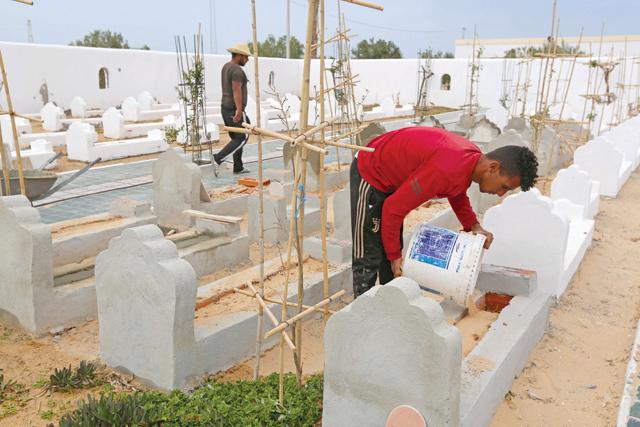You are here
Waiting to leave Libya’s ‘cemetery of the unknown’
By AFP - Dec 23,2015 - Last updated at Dec 23,2015

Abdelhamid Al Swei, who is in charge of transporting bodies to the cemetery for the Red Crescent, looks at the grave of an unidentified migrant at the Bir El Osta Milad Cemetery, dubbed by locals as the ‘cemetery of the unknown’, on the outskirts of the Libyan capital, Tripoli, on December 9 (AFP photo)
TRIPOLI — On the outskirts of Libya's capital, Imad wipes the dirt from the tombstone of his brother, one of hundreds of migrants whose journey ended in the "cemetery of the unknown".
No name is marked on the grave, but at least it has a date, and with the help of the Libyan Red Crescent, 29-year-old Tunisian Imad Ben Salem is now certain this is the burial place of his younger brother, Qabil, 25.
But an error by a doctor and red tape have prevented him from repatriating the body for the family to grieve back home.
Hundreds of migrants whose dreams of a new life in Europe were sunk in the Mediterranean are buried in Bir El Osta Milad cemetery, awaiting repatriation if their identities are confirmed.
"My brother died with 127 others on the third day of the Feast of the Sacrifice," the holiday marking the end of the annual Hajj [the greater Muslim pilgrimage to Mecca], in September, Imad told AFP.
"I was supposed to stay three days in Libya, a week at most," said the young Tunisian, who for more than a month has abandoned his job as a taxi driver on which eight members of his family are dependent.
"When I arrived, there was no paperwork and I came up against obstacles at every turn," he said, angrily.
"I call on the Libyan and Tunisian authorities, on the Red Crescent and the Red Cross: all I want is to take my brother's body back to Tunisia!"
Scattered under trees and between bushes, tombs are marked with the dates on which the bodies of hapless migrants were recovered from the water or washed up on Libya's shores.
Some of them date back to 2012.
If documents are found on the bodies, their names and nationalities are also marked on the tombstones.
300 graves ready
The Red Crescent has no precise figure, but says that several hundred men, women and children are buried in what locals have dubbed "the cemetery of the unknown".
"This experience will always be engraved in our memory. It's impossible to forget the corpses, We fear that one day we will be faced by someone we know," said Abdelhamid El Swei, who is in charge of transporting bodies to the cemetery for the Red Crescent.
In one corner of the cemetery, 300 graves have been dug ready for more migrants who perish at sea and are given funerals in keeping with Muslim rites.
Gravedigger Abderrazaq Abdelkarim recalls that they needed two days to prepare graves when a boat carrying 120 people sank a month ago.
The Red Crescent follows a set procedure: first, a frontline team is alerted, another is tasked with verifying the information and a third is sent to recover the bodies.
The remains are then handed to forensic doctors, registered with a case number and then buried in Bir El Osta Milad.
"Not long ago we were working seven days straight," said Hussam Nasr, a Red Crescent volunteer for the past 12 years.
He recalled one instance when they had to use ropes to haul five bodies from the water and 20 metres up a cliffside.
In the case of Imad's brother, the body was identified by the Red Crescent because of his tattoos.
But "the forensic doctor... failed to mention the tattoos in his report and the authorities refuse to carry out a DNA test although it's perfectly clear that this is my brother. I know he's here," Imad said.
"He was the youngest among us. I won't abandon him here. I will not leave without him."
Related Articles
ZARZIS, Tunisia — Armed with just a spade, Chamseddine Marzoug is determined to give a dignified burial to migrants who drowned in waters of
ZARZIS, Tunisia — A cemetery in southern Tunisia for migrants who drowned crossing the Mediterranean in the hope of a better life in Europe
GABES, Tunisia — A putrid odour lingers outside a morgue in Tunisia's coastal city of Gabes as dozens of bodies of would-be migrants to Euro














